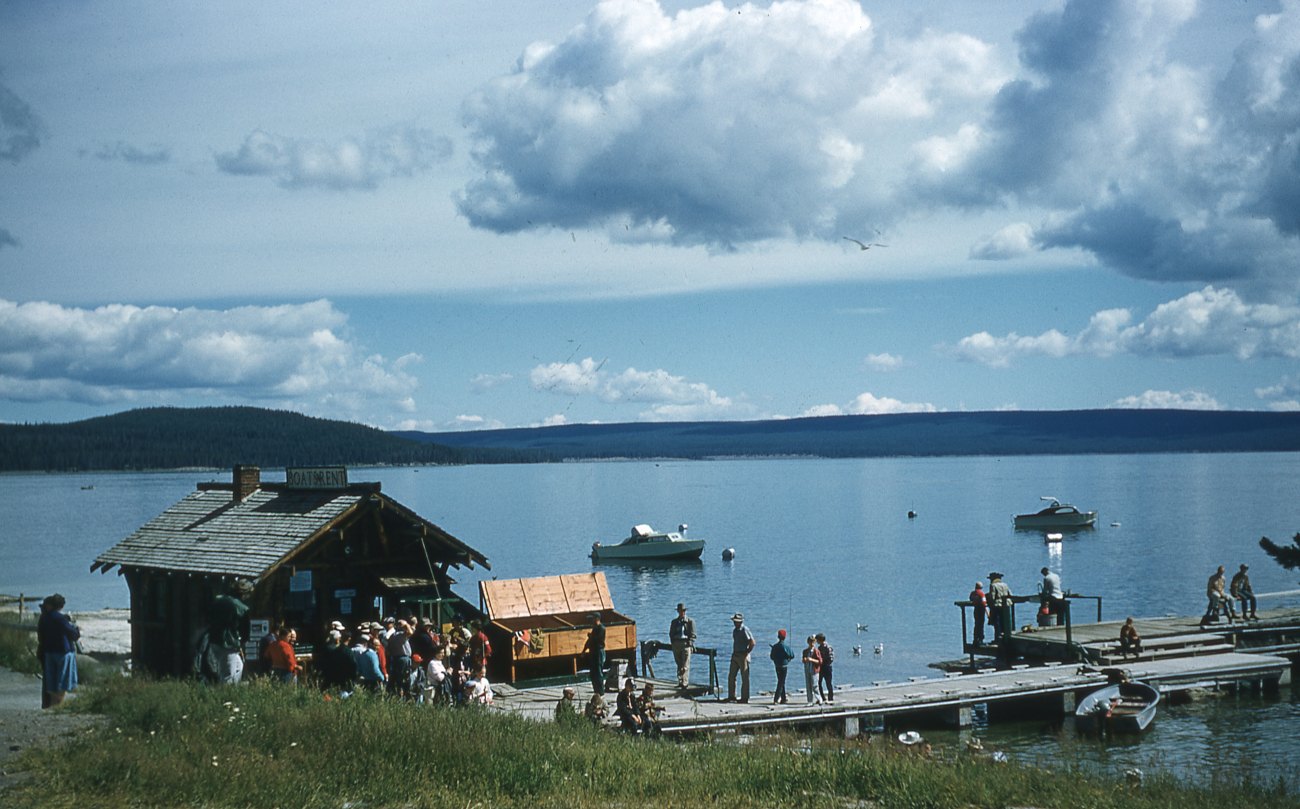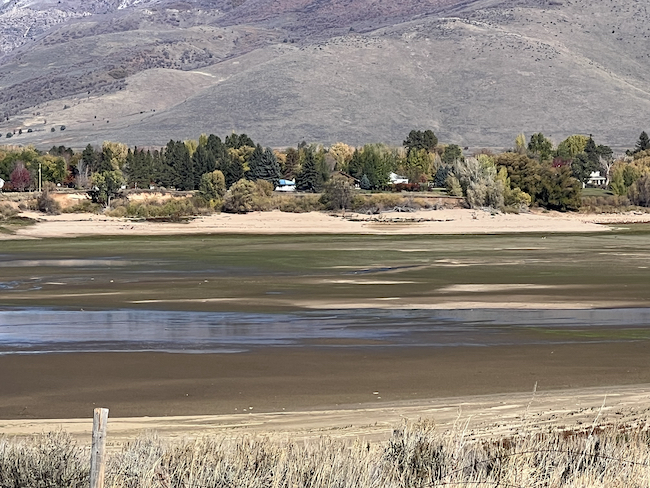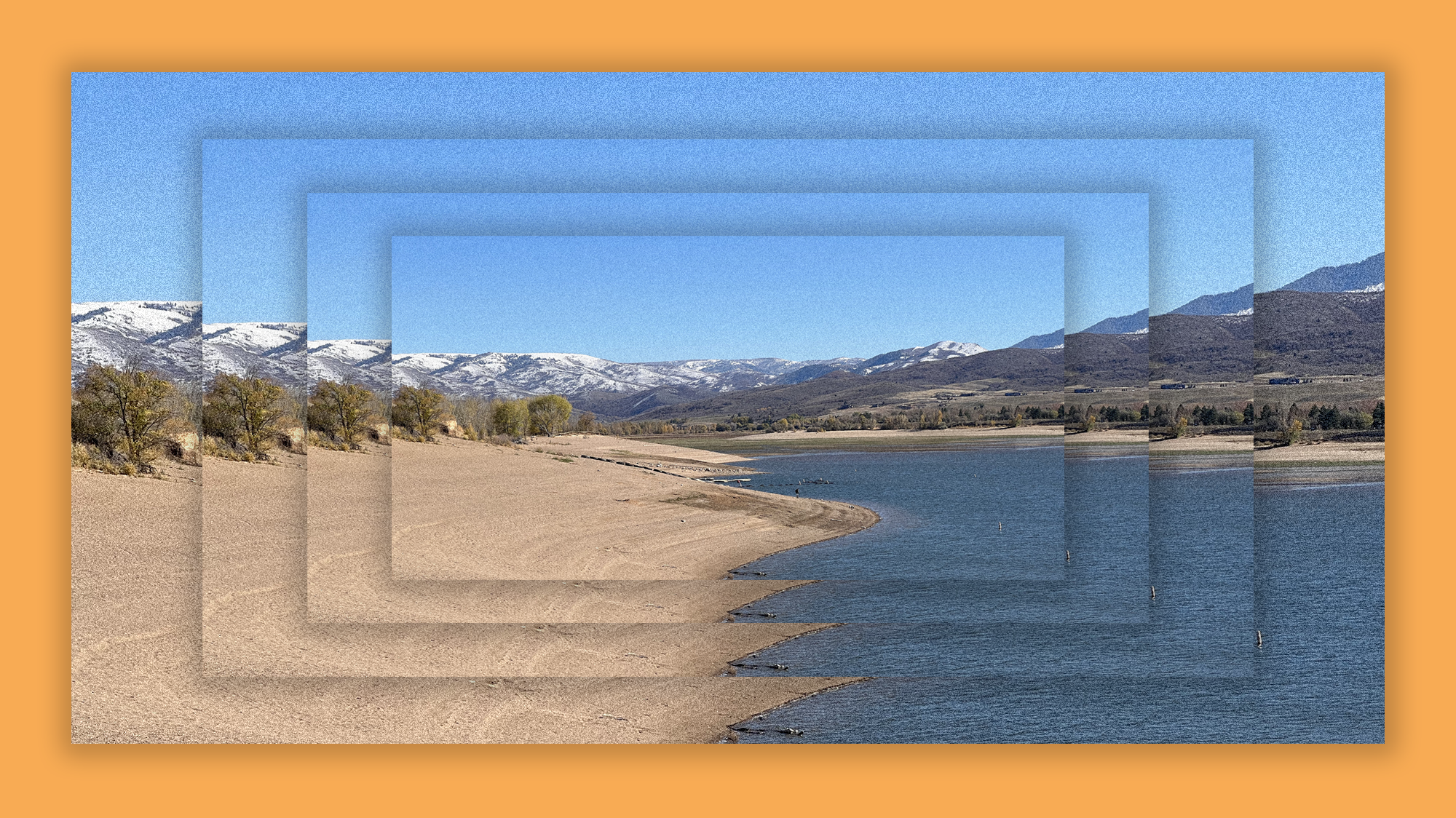Ogden, Utah, is a long way from the beach. To the west is the Great Salt Lake, a huge salty body of water, but one so stagnant, buggy, and smelly that no one would want to swim in it more than once. So instead, when I was growing up in Ogden, we went to Pineview Reservoir. Created by a dam on the Ogden River about 7 miles up in the Wasatch mountains, Pineview offered few of the charms of a natural lake, but it had the advantage of being close by. Locals waterskied there and fished for trout (but usually pulled up crappies). I windsurfed badly from its shores. It’s where we drank beer on boring summer nights and then tried not to die drunk driving home down the twisty canyon road.
At least one or two people usually drowned in Pineview every summer after getting hit by a boat, crashing a jet ski, or just failing to wear a life jacket. When my dad was in high school, he used to pull the bodies out as a rescue diver. Years later, I did my own scuba certification 20 feet down in the cold, murky waters where I couldn’t see my hand in front of my face. The ever-present possibility of bumping into a corpse gave the place an edgy, Twin Peaks vibe in my memories.
This summer, though, not many people were scuba diving in Pineview. Like much of the West, the entire state of Utah has been suffering from extreme drought. By October 1, Pineview, which supplies drinking water for half the year to more than 90,000 people, was filled to only 15 percent of its capacity, a near-record low. Water levels fell 20 feet below normal—one of the worst declines of any state reservoir. As water stories go, Pineview is a small one compared with say, the drying up of Lake Mead, which supplies drinking water to 25 million people in the Southwest and Mexico. But the place I frequented in my youth is a microcosm of the climate change–induced water woes facing the West as global temperatures rise and droughts become more severe, taxing Depression-era water infrastructure that’s now incapable of meeting the demands of 21st-century populations.
Years ago, the state drained Pineview for repairs to the dam and discovered a ’49 Ford featuring a toilet bolted to the driver’s side floor in lieu of a seat. My dad’s high school auto shop buddies had rolled their class project into the reservoir late one summer night in 1966, after failing to find a reliable parking space for it after graduation. Cars, mostly stolen, have now been surfacing regularly in Pineview as the water recedes. The sheriff’s department had to rescue some boaters this summer after they crashed their boat at 20 miles an hour into a sandbar where deep water should have been. Islands are forming.
High temperatures and low water levels are also disrupting the reservoir’s already tenuous ecosystem. In 2019, thousands of young black crappies washed up on shore in a massive die-off. In 2018, Pineview suffered the first of several major toxic algae blooms—sheets of green slime encouraged by high temperatures and some help from lawn chemicals and agricultural fertilizer that also drain into the reservoir. The health department warned people not to swim there or to let their pets in, as cyanobacteria in the green slime can be fatal to animals and make people sick. It closed a beach and marina that year.
During the summer of 2021, the algae returned, along with high levels of E. coli from dubious septic systems in the valley. But Pineview was already so low that at least one boat dock had to be closed early in June, limiting the usual parade of power boats. (That didn’t prevent four people from drowning by July, however.) In September, the XTerra off-road triathlon had to cancel its swimming leg because the reservoir was too toxic to race in.

Scene on the shores of the Pineview Reservoir, in Ogden Valley, Utah, June 1958. At left foreground is a boat rental shack surrounded by a crowd of visitors waiting on the dock.
Morse Collection/Gado/Getty
The state of the reservoir isn’t totally surprising. Pineview has always been something of an unnatural place in an otherwise wild space. With its concrete retaining walls and artificial shorelines, the reservoir is like a bathtub (or toilet, depending on your perspective) planted on the edge of the Uinta-Wasatch-Cache National Forest in the lovely Ogden Valley, where elk, deer, wild turkeys, and quail frequent the riparian areas along the Ogden River. Construction on Pineview started in 1934, during the glory days of western dam building, when the federal Bureau of Reclamation was overseeing the breakneck construction of Hoover, Shasta, Bonneville, and Grand Coulee—the largest concrete dams ever built.
At the time, Ogden was grappling not with intense droughts but with major flooding. The original 600-foot-long concrete dam was part of the Ogden River Project, designed to control spring flooding and provide irrigation for farmers working the spit between the Wasatch mountains and the Great Salt Lake. At more than 5,000 feet above sea level, Pineview’s stored bounty flowed easily down the mountain to Ogden to provide drinking water and irrigation to farms and even a couple of golf courses. But like so much of the West, the area has seen explosive growth over the past 20 years. Ogden City has about 30 percent more residents than it did when I left for college; the surrounding Weber County population has surged 65 percent since 1990.
Utah is the third-driest state in the country. Weber County gets about 21 inches of rain a year. Just 40 miles west, annual rainfall in the the Great Salt Lake desert drops to about 5 inches, and the summers have always been hot. Theoretically, few people should be able to live here without starving to death. The nomadic Ute tribes believed that staying in one place meant certain death because the harsh climate obviously was not amenable to farming. But the Mormon pioneers who came over the mountains fleeing religious persecution in the mid-1800s made the desert bloom.
“Without realizing it, they were laying the foundation of the most ambitious desert civilization the world has seen,” wrote Marc Reisner in his 1986 classic Cadillac Desert: The American West and Its Disappearing Water. “In the New World, Indians had dabbled with irrigation, and the Spanish had improved their techniques, but the Mormons attacked the desert full-bore, flooded it, subverted its dreadful indifference—moralized it—until they had made a Mesopotamia in America….And if history is any guide, the odds that we can sustain it would have to be regarded as low.”
As the Harper’s columnist and Ogden native Bernard DeVoto observed back in the 1950s, the Wasatch Mountains are like “humid islands” in the desert sea of the Mormon Mesopotamia. Thousands of feet above the valley, the rugged peaks trap snow in the winter. In the spring the snow melts and runs off into the valley, where the Mormons, later with help from the federal Bureau of Reclamation, would build a series of reservoirs like Pineview to store that spring runoff for irrigation and drinking water. “Desert and mountains have exerted an absolute determinism,” DeVoto wrote of the fate of people in Utah. “Every generation has to learn that it is subject to no exception.”
We are relearning that lesson now. Pineview’s massive drop in water levels didn’t start this year, but in 2020, previously the state’s driest year on record. After 2020’s boiling hot summer, 2021 started off with below average snowpack and Pineview got only about 15 percent of the normal spring runoff. Most of that was soaked up by the parched earth before it could replenish the reservoir. In September of this year, after the state’s hottest summer on record, the water district shut off “secondary water” supplies from Pineview early because water that had promiscuously sprinkled people’s lawns (and often sidewalks) for years in this arid desert was simply gone.
The Washington Post this month reported on a new study in Nature Reviews Earth and Environment predicting that the snowless mountains we’re seeing in Utah may indeed be the new normal. Thanks to climate change, the authors warn, “the potential for persistent low-to-no snow to disrupt the [Western US] water system is substantial, potentially even catastrophic.” The study predicted such a scenario 35 to 60 years out, but in Utah, the future already seems here. Just look at Pineview.
Utah’s elected leaders’ response to the water crisis has not been encouraging. Over the summer, Utah Gov. Spencer Cox called on help from a higher power. “We need more rain and we need it now,” Cox said in an official statement. “We need some divine intervention. That’s why I’m asking Utahns of all faiths to join me in a weekend of prayer June 4 through the 6th.” While residents dutifully prayed for rain, the state legislature once again shot down even the most elementary water conservation measures, like a proposed bill that would have required low-flow toilets and shower heads in new construction.
Many Utah politicians are openly skeptical of climate change. During a September meeting of the state legislature’s Natural Resources, Agriculture and Environment Interim Committee on the drought and other water issues, legislators viewed a video from the right-wing propaganda outfit PragerU on the evils of renewable energy. Redge Johnson, the executive director of the governor’s Utah Public Lands Policy coordinating office, testified that what the state really needed to do was cut down more trees, which he said were causing forest fires. “Every one of those additional trees over historic norm is a straw taking water out of the system,” he alleged.
So when I recently started asking questions about what the long-term plan was for Pineview, I was surprised to learn that the local water officials in charge aren’t just praying for a good snow year right now. Pineview is one of seven reservoirs managed by the Weber Basin Conservancy District, a utility created in 1950 as the local sponsor for Bureau of Reclamation water infrastructure projects. Today it’s the water supplier for 700,000 residents in a five-county area around Ogden. Jon Parry, the district’s assistant general manager, received both his BS and master’s degrees in civil engineering at Brigham Young University in Provo, an LDS church–owned school not known for producing many radical eco-warriors. But he’s not a climate change denier either.
Parry is not quite prepared to say Pineview’s diminished state might be the new normal. “Hopefully it’s an event that we don’t see very frequently,” he told me. But his water district recently commissioned a climate vulnerability study to help prepare for a hotter future. Parry says the study can’t predict exactly how the region might change: will the disappearing snow be replaced by more rain, and thus more floods? Or will it simply suffer more drought? No one can say for sure. But the overall conclusion shows what already seems obvious: The Wasatch front, where two-thirds of Utah’s population resides, will not have enough water to support its current exponential growth. The real estate developers, however, don’t seem to have gotten the memo.
In 2013, some out-of-state tech bros backed by the billionaire Trump supporter Peter Thiel bought my beloved Powder Mountain, a tiny, uber-local ski resort about 15 miles from Pineview. The place where I grew up skiing for $15 lift tickets has been turned into “a utopian club for millennial elites,” as the Guardian described it, with planned construction of exclusive homes to create a community of “likeminded millionaires” bought up by the likes of Virgin Airlines founder Richard Branson and four-hour lifestyle guru Tim Ferriss. * Lift tickets now cost $135 a day—about five times higher than the rate of inflation from my high school days.

The “picaresque” view of Pineview Reservoir from the Escapes at Edgewater, Eden, Utah.
Stephanie Mencimer/Mother Jones
The bros host conferences they describe as “Davos for millennials,” where they can ruminate on their philanthropy in a beautiful mountain setting. The problem, of course, is that all this elite real estate needs water. Powder Mountain’s new owners spent several years fighting with farmers in the valley below over water rights. In August this year, the Wolf Creek Water and Sewer Improvement District took the rare step of halting water hookups for new construction south of Powder Mountain because of dwindling supplies, infuriating developers. The move effectively halted the sprawl of multimillion-dollar mountain chalets for now.
I hadn’t been up to Pineview in many years, so in mid-October, I drove up there with my mom. Childhood friends from Ogden had warned me that it was a shocking sight. They were right. The “beaches” were long stretches of sand where water used to lap. As we drove the 28 miles around the lake, I was dumbfounded by the new development—luxury homes abutting a shoreline my teenage self would never have predicted becoming anyone’s idea of luxury. We pulled in to one of these places still under construction called “Escapes at Edgewater,” touted as “luxury lakefront homes” with a view of the “picaresque Pineview reservoir.”
Whether Pineview recovers in time for next year’s boaters and floaters all depends on this winter’s snowfall. So far, it’s not looking promising. The snowpack in the Wasatch mountains around Pineview is currently at 50 percent of normal. And no amount of unicornage can make it snow at Powder Mountain, a resort that usually opened by Thanksgiving when I was a kid. As of December 13, it was still closed. That was one way of describing it. On the day we took it in, the “picaresque” view was mostly mud flats. Two of the houses were already occupied, and signs indicated that the development was mostly sold out. We wondered if those buyers were having second thoughts about their purchases, or if they just assumed that the water would come back. I tried to ask the developer, but my phone messages went unreturned.
In the grand scheme of things, a shrinking Pineview probably does not rise to the level of a climate catastrophe like the massive California fires or the floods in Hawaii. Ogden City has other sources of drinking water. People will finally have to get rid of their lawns. And yet, Pineview’s slow death feels like another one of those small yet brutal blows to the soul from unchecked climate change—mortal grief caused by the irreversible loss of even ordinary landscapes we once took for granted. Pineview has always been a crappy fake lake, but it was our crappy fake lake, a repository of generations of memories and a ’49 Ford. I am mourning as I watch it die.
Clarification: After this story published, Ferris contacted Mother Jones and said, “I sold my plot of land at Powder Mountain years ago to distance myself from a lot of what’s happening there.”










